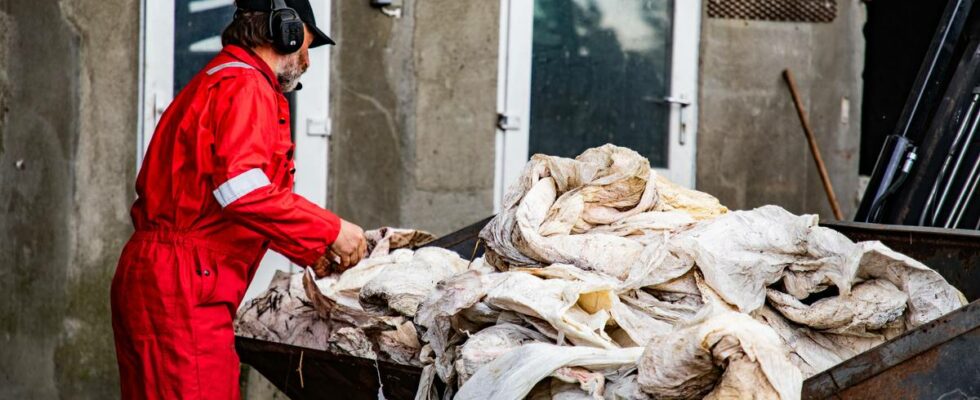Alongside his work with pigs, cows and grain, Andreas Aarsland in Kvernaland collects agricultural plastic from almost the entire municipality. – Someone has to do it, says Aarsland in a broad Jæren dialect. Farmer Andreas Aarsland looks out over the cornfield. In addition, he has pigs and cows – and containers full of agricultural plastic. Photo: Philip Kollstrøm / news If the farmer receives less than ten tonnes in a month, he will be disappointed. – Yes, or nine is fine. But below nine, then we are dissatisfied, he adds. Did you know that in 2021 there will be a new return scheme for more farmers in Norway? Read more about it here. He has been doing this for over 20 years on behalf of the organization 4H, but he gets nothing for it. – I only get expenses, he says and laughs. Because of Aarsland and other farmers, Norway is probably at the top of Europe in recycling agricultural plastic, says Arve Martinsen, communications manager for industry in Grønt Punkt Norge. Almost all plastic is recycled Tractor eggs or round bales, vegetable cloths and solar collector foils are some of what Aarsland collects. Many people may be familiar with these plastic balls, which some call tractor eggs. Much of the plastic from here can end up in nature, but at Aarsland it ends up at a recycling station in Vigrestad. Photo: Philip Kollstrøm / news In the course of a year, Norwegian farmers use over 20,000 tonnes of agricultural plastic, and in 2023 93 per cent of the plastic was recycled, figures from Grønt Punkt Norge show. In 2022, only 77 percent of the plastic was recycled. – If we are the best in Europe, I also believe that we are the best in the world, says Agriculture Minister Geir Pollestad to news. Agriculture Minister Geir Pollestad is very proud of Norwegian farmers, he tells news. Photo: Philip Kollstrøm / news He believes that Europe has a lot to learn from Norwegian farmers. Plastic collection in Norway is based on voluntary work from the farmers, says Pollestad. Either by the farmers driving and collecting the plastic from the farms or by local farmers’ associations and organizations facilitating plastic delivery. – There is a general awareness in society that you should not pick things up, but rather reuse or recycle, says farmer Andreas Aarsland. This is what has meant that so much can be recovered, says Pollestad. – Agricultural plastic is a success story According to the head of Greenpeace Norway, Frode Pleym, Norwegian farmers deserve a lot of praise. Agricultural plastic has long had a high recycling rate. Pleym is happy that it is still going up. – Agricultural plastic is a success story. The fact that it is above 90 per cent is fantastic, he says. Anything less than 100 percent is too little, believes Greenpeace Norway leader Frode Pleym. Photo: ISMAIL BURAK AKKAN / news But still this is not good enough, he clarifies. – The problem is that anything below 100 per cent is too little. Any amount of plastic that is not collected ends up in nature, says Pleym. But microplastic emissions must also decrease. In contrast to the agricultural plastics, which can be large pieces of plastic, the microplastics are very small plastic flakes such as those from car tires or synthetic clothing. Here we have a lot to go on, says Pleym. – A proper effort is needed to remove sources of plastic pollution in nature, he says. Lots of dirty plastic Last year, farmer Andreas Aarsland received over 100 tonnes of plastic, but much of the plastic was dirty. – People could have been better at delivering cleaner plastic. Then you could get more use out of it, he says. Andreas Aarsland has collected agricultural plastic for over 20 years Photo: Philip Kollstrøm / news Much of the agricultural plastic can often be full of moisture, soil residues and fertiliser. Figures from Grønt Punkt Norge show that 48 percent of the agricultural plastic that comes in for recycling must be rinsed. In the past it has not been as big a problem, but in recent years plastic use has increased among farmers. It also has the need for good recycling. – Now they use more plastic bales than silo towers, says the farmer. First it is on the ground, then it ends up in the container. Philip Kollstrøm / news Published 16.07.2024, at 14.14
ttn-69
93 percent of agricultural plastic is recycled. Norwegian farmers probably at the top of Europe – news Rogaland – Local news, TV and radio

